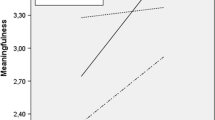Abstract
The self-image of a group of 177 adolescents talented in one of five areas — mathematics, science, music, athletics, and art — was compared to that of a normal group of teenagers, using the Offer Self-Image Questionnaire for Adolescents (OSIQ). In addition, correlations between the talented OSIQ scores and instructor ratings of engagement and aptitude in the talent area was obtained. The findings indicate that talented adolescents educated in a normal high school setting evidence patterns of self-image and esteem very similar to their more average peers. The talented teenagers, however, also report considerable uncertainty involving issues of sexual and social competence. Discussion focuses on the implications of these findings for later patterns of talent development.
Similar content being viewed by others
References
Austin, A. B., and Draper, D. C. (1981). Peer relationships of the academically gifted: A review.Gifted Child Quart. 25: 129–133.
Beane, J. A., and Lipka, R. P. (1982). The peer group and the transescent self in school.Transescence 10: 10–17.
Beane, J. A., and Lipka, R. P. (1986).Self-Concept, Self-Esteem and the Curriculum. Teachers College Press, New York.
Brody, L. E., and Benbow, C. P. (1986). Social and emotional adjustment of adolescents extremely talented in verbal and mathematical reasoning.J. Youth Adoles. 15: 1–17.
Cohn, S. J. (1981). What is giftedness: A multi-dimensional approach. In Kramer, A. H. (ed.),Gifted Children: Challenging Their Potential. Trillium Press, New York.
Coleman, J. L. (1961).The Adolescent Society. Free Press, New York.
Csikszentmihalyi, M., and Larson, R. (1984).Being Adolescent. Basic Books, New York.
Csikszentmihalyi, M., and Robinson, R. (1986). Culture, time, and the development of talent. In Strenberg, R. (ed.),Conceptions of Giftedness Cambridge University Press, New York.
Erikson, E. H. (1958).Young Man Luther. W. W. Norton, New York.
Erikson, E. H. (1975).Life History and the Historical Moment. Norton, New York.
Foster, W. (1981). Leadership: A conceptual framework for recognizing and educating.Gifted Child Quart. 25: 17–25.
Gagne, F. (1985). Giftedness and talent: Reexamination of the definitions.Gifted Child Quart. 29: 103–112.
Gardner, H. (1982).Frames of Mind. Basic Books, New York.
Goswick, R. A., and Jones, W. H. (1981). Loneliness, Self-concept and adjustment.J. Psychol. 107: 237–240.
Kaiser, C. F., and Berndt, D. J. (1985). Predictors of loneliness in the gifted adolescent.Gifted Child Quart. 29: 74–77.
Lombroso, C. (1895).The Man of Genius. Charles Scribner, New York.
Marland, S. P. (1972).Education of the Gifted and Talented: Report to the Congress of the United States by the U.S. Commissioner of Education. U.S. Government Printing Office. Washington, DC.
Newland, T. (1976).The Gifted in Socio-Educational Perspective. Prentice-Hall, Englewood Cliffs, NJ.
Offer, D., Ostrov, E., and Howard, K. I. (1978).The Offer Self-Image Questionnaire for Adolescents. Michael Reese Hospital and Medical Center, Chicago.
Offer, D., Ostrov, E., and Howard, K. I. (1981).The Adolescent. Basic Books, New York.
Offer, D., Ostrov, E., and Howard, K. I. (1982). Family perceptions of adolescent self-image.J. Youth Adoles, 11: 281–291.
Offer, D., Ostrov, E., and Howard, K. I. (1984). Body image, self-perception, and chronic illness in adolescence. In Blum, R. W. (ed.),Chronic Illness and Disabilities in Childhood and Adolescence. Grune & Stratton, New York.
Piechowski, M. M., and Colangelo, N. (1984). Developmental potential of the gifted.Gifted Child Quart. 28: 80–88.
Powell, P. M., and Haden, T. (1984). The intellectual and psychosocial nature of extreme giftedness.Roeper Rev. 6: 131–133.
PSAT/NMSQT Interpretive Manual (1987). College Entrance Examination Board.
Purkey, W. W. (1966). Measured and professed characteristics of gifted high school students and an analysis of their congruence.J. Educat. Res. 60: 99–104.
Renzulli, J. S. (1979).What Makes Giftedness: A Reexamination of the Definition of the Gifted and Talented. Ventura County Superintendent of Schools Office, Ventura, CA.
Roth, J., and Sussman, S. (1974).Educating Gifted Children. York Borough Board of Education, Toronto.
SPSS, Inc. (1983).SPSS-X User's Guide. McGraw-Hill, New York.
Strang, R. (1963). Gifted adolescents' views of growing up. In Crow, L. D., and Crow, A., (eds.),Educating the Academically Able. David McKay Company, New York.
Tannenbaum, A. J. (1962).Adolescent Attitudes Toward Academic Brilliance. Bureau of Publications, Teachers College, Columbia University, New York.
Terman, L. M. (1925).Mental and Physical Traits of a Thousand Gifted Children. Stanford University Press, Stanford, CA.
Tidwell, R. (1980). A psycho-educational profile of 1,593 gifted high school students.Gifted Child Quart. 24: 63–68.
Witty, P. A., and Lehman, H. C. (1929). Nervous instability and genius: Poetry and fiction.J. Abnorm. Social Psychol. 24: 77–90.
Wylie, R. C. (1979). The Self-Concept: Theory and Research (Vol. 2, rev. ed.). University of Nebraska Press, Lincoln, NB.
Author information
Authors and Affiliations
Additional information
This study is part of a longitudinal study of talented adolescents supported in full by a grant from the Spencer Foundation.
Research interests include adolescent self-concept and the psychology of challenging experience.
Research interests include the psychology of adolescence and the study of optimal experience, creativity, and intrinsic motivation.
Rights and permissions
About this article
Cite this article
Whalen, S., Csikszentmihalyi, M. A comparison of the self-image of talented teenagers with a normal adolescent population. J Youth Adolescence 18, 131–146 (1989). https://doi.org/10.1007/BF02138797
Received:
Accepted:
Issue Date:
DOI: https://doi.org/10.1007/BF02138797




